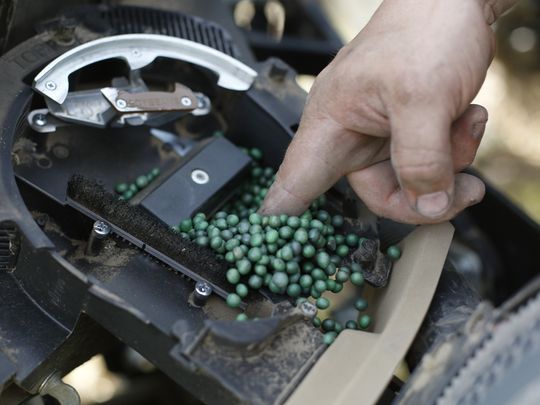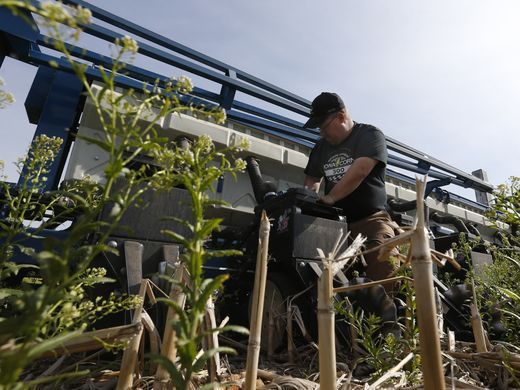The Des Moines Register: Make or break year? Iowa farmers battle for profits after 3 years of falling income, rising delinquencies
Published 5:57 p.m. CT May 18, 2017
Watch as Michael Fritch plants soybeans on his home farm in Mitchellville, Iowa, and shares his thoughts on the current state of the farm economy. Michael Zamora/The Register
When his 31-row planter broke down while sowing soybeans earlier this month, Michael Fritch and his dad patched it up as best they could, after deciding to put off buying new equipment for awhile.
It’s one more way to cut costs with commodity prices dismally low and a farming downtown now in its fourth year.
“There’s no question, you do you stress about it,” said 39-year-old Fritch, who farms near Mitchellville.
This year could be a pivotal for many Iowa farmers, battling to turn a profit as they plant 23.4 million corn and soybean acres across the state.
Financial pressure is beginning to show.
- Iowa farmers are leaning more on debt, with production loans climbing 39 percent to $8.4 billion over the past five years, federal bank data shows.
- Loans 30 days or more past due have increased 180 percent to about $84 million since 2011, Federal Deposit Insurance Corp. data shows.
- Even so, the delinquency rate, while pushing higher, remains near 1 percent, based on loan data provided by Ohio State University.
Delinquency rates are rising from record lows to around historic averages, said Chad Hart, an Iowa State University agricultural economist.
Record corn and soybean production last year helped blunt the financial drag, but farmers are paying for it this year as the glut of grain depresses prices, he said.
“There could be a wave of financial issues still coming in the farm sector as we continue to see low prices and the erosion of the farm financial sheet,” Hart said.
Bankruptcy’s limitations
Unlike the financial failures and farm auctions that haunted rural Iowa during the 1980s ag crisis, the state so far has seen few bankruptcies in this latest agriculture downturn.
Over the past five years, 52 Iowa farmers have filed for bankruptcy through Chapter 12, the law established to help growers through a financial disaster.
That is a tiny fraction of Iowa’s 132,000 growers who raise livestock and crops on nearly 90,000 farms.
Joseph Peiffer, a Cedar Rapids bankruptcy attorney, said the law that allows farmers to reorganize probably isn’t a good avenue for them for a couple of reasons.
Growers have to show lenders they have a path to profitability.
“If you can’t show a realistic cash flow that makes some money,” Peiffer said, “it’s difficult to propose a bankruptcy plan that can get confirmed” by the courts.
Farmers also might look to other bankruptcy choices because Chapter 12 limits debt to $4.15 million.
“Many of the grain and livestock farmers who come see me have debt that far exceeds that amount,” Peiffer said.
Michael Hein, vice president of Liberty Bank & Savings Bank in Davenport, said lenders might look at more widespread debt restructuring after this growing year with continued low prices and shrinking cash reserves.
“Very few lenders are anxious to pull the trigger and try to move things into foreclosure,” Hein said.
Rising farm debt
Debt for Iowa farmland and other real estate has climbed 50 percent to $8.6 billion over the past five years, federal commercial bank data shows.
The amount of delinquent loans also has risen 55 percent to nearly $93 million.
Still, the delinquency rate for ag real estate has inched only to about 1.1 percent.
Even so, like commercial banks, Farm Credit Services of America, part of the $248-billion system that provides about a third of U.S. farm lending, sees some distress.
Loans to producers in Iowa, Nebraska, South Dakota and Wyoming grew to $25.2 billion last year, a 6.5 percent increase over 2015 and a nearly 60 percent spike over 2011.
Farm Credit Services of America’s at-risk loans climbed to $178.7 million last year, more than doubling over three years.133% since 2014
Iowa makes up about 38 percent of the system’s loans, the group said.
The Omaha-based lender hired about two-dozen loan officers and credit analysts to help farmers through the downturn. The work includes restructuring debt to help improve farmers’ cash flow.
Mark Jensen, Farm Credit Services chief risk officer, estimates that about half its farmers have lowered their costs for seed, chemicals and other inputs they need to grow a crop so they can get closer to breaking even at $3.25 to $3.75 a bushel for corn.
“Commodity prices have been cut in half, and our data would show costs have come down 10 to 15 percent,” Jensen said.
“After three years, that’s taking a toll.”

Michael Fritch pokes through the soybean seeds as he checks to make sure one of his planters is working properly Tuesday, May 9, 2017, as he plants soybeans on his home farm in Mitchellville. (Photo: Michael Zamora/The Register)
Still, problem loans made up only 0.7 percent of the Farm Services’ total portfolio.
Last year’s bin-busting yields helped slow “the deterioration we expected to see last year,” Jensen said. “But it doesn’t correct any of the fundamental challenges. It continues to build on record or near-record inventory levels.”
‘Volumes of bushels’
Iowa farmers harvested record crops last year — 2.74 billion bushels of corn and 593 million bushels of soybeans — besting 2015 production that also set a record.
Iowa led the nation in corn production last year and ranked second in soybeans.
Even with strong yields, many Iowa farmers still might not have made money, said Northey, the state’s ag secretary who farms near Spirit Lake.
If Iowa follows national trends, state farm income would shrink to $4.3 billion by 2017, which would make it the lowest level since 2010.
In 2015, Iowa farm income was $5.6 billion, according to the most recent U.S. Department of Agriculture data available.
State leaders largely blame the farm slump, and manufacturing job losses connected to agriculture, for a nearly $250-million budget shortfall this fiscal year that they had to cover with spending cuts and savings.
Still, Steve Bruere, president of the Peoples Co., a Clive farm brokerage and management business, sees improving conditions.
In March, none of Peoples Co.’s farm clients were delinquent on rent payments or pushed for last-minute lease renegotiations — far different than in 2015.
And Bruere said land values are stabilizing. Iowa farmland values have fallen about 18 percent to $7,183 an acre from a 2013 record high, according to ISU land surveys.
“One thing to our advantage has been good yields,” Dennis Friest, who farms near Radcliffe with his son, Brent. “We’ve had volumes of bushels produced. And that helps ease the pain of lower prices.”
Friest is cutting costs, a common discussion in Iowa coffee shops. Friest has found he can save about $40 an acre cutting some seed traits when he plants corn after soybeans.
And Fritch, who farms near Mitchellville, said he and his father are buying seed and other inputs in bulk to get lower prices.
Both Fritch and Friest have also negotiated lower rents, a big savings for farmers.
“It would be nice to have at least $3.25 to $3.50 a bushel, but we’re struggling to get there right now,” Friest said.
Corn prices averaged $3.24 a bushel in Iowa last week; soybeans, $8.94.
Some producers have sold equipment that’s not critical to their operations. “It’s not folks doing it out of desperation, but maybe strategically,” Northey said.
A few farmers are quietly selling land to investors, on the condition that they’re able to continue farming it, said Jason Smith, a broker and auctioneer with Dream Dirt, an ag real estate and management company in Mondamin.
Corn remains king in Iowa, but a look at recent data from the U.S. Department of Agriculture shows soybean production is increasing in the Hawkeye State.
Worried about trade
In a year of uncertainties, trade could be the biggest.
Any bumps in demand for grain and livestock exports would be troublesome for an industry fighting to hang on.
“If we have another bumper crop … we could take these markets another step down,” Hart said. “I’m hoping for an average crop, not a great crop.”
Working through the glut of U.S. grain will take a couple years or more, he said.
President Trump has threatened to tariffs on trade with China, Canada and Mexico, and announced Thursday he will renegotiate the North America Free Trade Agreement with neighbors in Canada and Mexico.
“The trade policy uncertainty has the potential to do more harm than good to the ag markets right now,” Hart said.
U.S. Ag Secretary Sonny Perdue created an undersecretary position directly overseeing trade. He said in Iowa he expected to have NAFTA renegotiated within six months.
In the meantime, Iowa exports fell 20 percent last year to $12.1 billion from a peak in 2014.
Reduced exports reflect, in part, lower prices for corn and soybeans. But the volume of products remains strong, said Dermot Hayes, an ISU ag economist.
Iowa tends to use most of its corn, and a lot of its soybeans, Hayes said.
The state leads the nation in ethanol, biodiesel, pork and egg production. It ranks seventh in beef production.
“With two bumper crops, Iowa has become an exporter of corn again,” Hayes said.
“Given our enormous harvests, prices have remained pretty good. $3.20 is better than $2 corn” farmers saw before Iowa’s ethanol boom in 2006, he said.
Despite the economic uncertainty, Fritch said wants his young sons and daughter to eventually join the business that has been in their family for five generations.
“I have faith in God that I can put the seed in the ground and trust that there will be a crop,” he said.
And that he’ll get a good price for it.
Iowa farmland values dropped 5.9 percent this past year, marking the third straight year land values have dropped. Register photos

